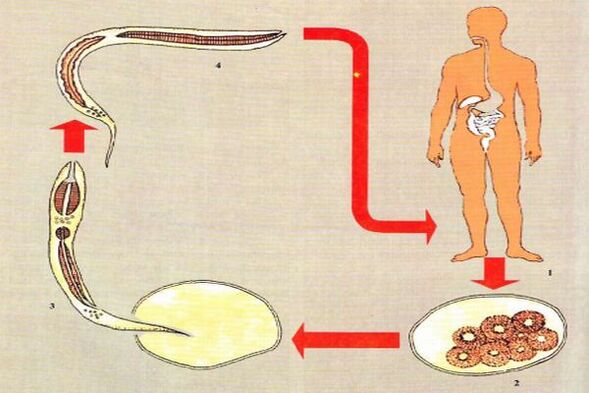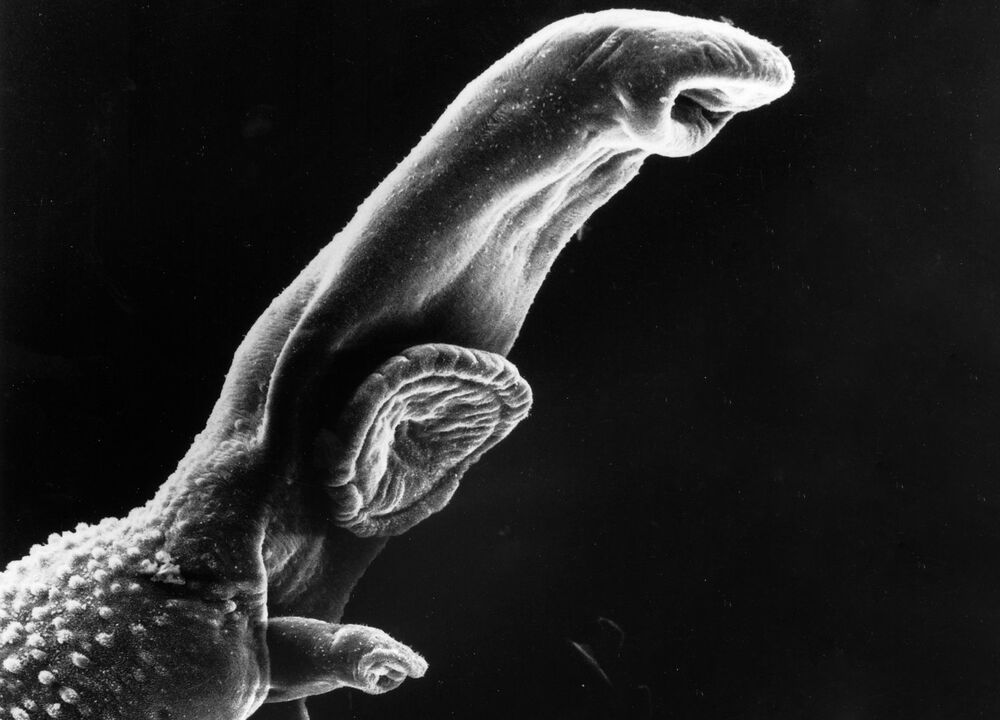Life cycle- this is the totality of all stages of development "from egg to egg", and in the absence of an egg, from any stage to the closest similar one. The main biological aspects of the life of any organism are adaptations that ensure the preservation of the individual and the species.
In parasites (unlike free-living animals), nutrition is provided continuously and thus increases the reproductive activity of the body. The increase in reproduction of the parasite due to the spatial and temporal limitation of its habitat leads to a rapid overpopulation of this place and the related need for resettlement of the species for its conservation.
The totality of all stages of the ontogeny of the parasite and the routes of its transmission from one host to another is called the life cycle.
Forms of cycles
Having found out that parasites are organisms that use other living things for their development, it is important to understand what options exist for the development of life. According to the classification, there are simple and complex cycles. The first occurs without a change of owner. Examples include the development of roundworms, amoebae, whipworms, and so on. A complex group includes multiple hosts at the same time. These can be vertebrates, fish, crustaceans and so on. An example is helminths.
The development cycle of whipworms does not require an intermediate host.
After entering the final host, the parasites grow and multiply. Depending on the type of pathogen, the larvae can remain inside or leave the body. In most cases, excretion occurs through the intestine. This allows you to determine the type of pathogen through simple tests.
Characteristics of cyclical phases
Each development stage has its own characteristics. Treatment is also determined based on this factor alone. This is explained by the fact that, for example, not all drugs work on larvae, while it is much easier to get rid of mature parasites.
The intermediate and final carrier of the parasite depends on the type of helminthiasis.
In this regard, let's see how the development cycle proceeds:
- Dispersal: This cycle exists when the intermediate host, which is the source, but not the final stage, is considered the only option at the moment, i. e. there is no potential final host. In such a situation, the intermediate host is used for further development and nutrition.
- Active growth: once the most suitable conditions have been reached, the parasite stops, establishes itself if suitable devices exist and begins its growth until the sexually mature state.
- Migration to another habitat: After a mature individual has reproduced eggs, in most cases it migrates for further development. They can be distributed in several ways. Most often, parasites migrate through the digestive system along with the food mass. There are also those that, due to their size, easily penetrate the bloodstream and spread throughout the body.
- Asexual reproduction: Some types of parasites are distinguished by the fact that they do not require a second partner for reproduction. The most striking example is the tapeworm, in which each strobile has a uterus that reproduces mature eggs.

Important concepts
The first thing to point out when learning about parasites is the concept of "host. "This is an organism in which the development and reproduction of parasites occurs. The "intermediate guest" stands apart. In this case, the pathogen remains inside the body until it has the opportunity to migrate to the more favorable environment, provided by the final host.
The cycle can occur with a change of 1-4 guests. In this case the first is intermediate and the rest is additional. Through direct contact or through an intermediate host, the parasites enter the final host. This is where sexual development and reproduction occur.
The development of the parasite begins when it enters the final host.
There are also concepts such as reservoir parasitism and host feeder. In the first case it is a situation in which the parasite, having reached suitable conditions, can remain unchanged for a long time, waiting for a more favorable settlement option.
Vendor ownerit is an organism that is used exclusively as food. The simplest option is pliers. By finding out how parasites of this type feed, it is possible to understand that they need human blood to exist, but do not remain in or on the human body for a long period of time.
The concept of "parasite reservoir" or "host reservoir" is also distinguished. It is a host in whose body the pathogen can live for a long time, accumulating, multiplying and spreading in the surrounding area.
Parasite biology
Carriage of parasites is considered separately: in the case of pathogenic parasites that live in the human body, but the development of the disease does not occur. However, such a person poses a danger to others.
The parasite and its host influence each other.
Harmful effects of the parasite on the host:
- Mechanical;
- Toxic;
- Food collection;
- Violation of tissue integrity.
As a result, the host's body "reacts" to the influence of the parasite.
Infections caused by parasites can be divided based on the susceptibility of the pathogen to the host:
- Anthroponotic: humans act as hosts;
- Zoonotic: Various animals serve as hosts;
- Anthropozoonotic diseases are invasive and infectious diseases common to humans and animals.
Medical parasitology includes 3 main sections:
- Protozoan parasites - protozoology.
- Parasitic worms, helminths - helminthology.
- Arthropods - arachnology.

Life cycle stages
In most cases, protozoa have special stages suitable for transitioning from one host to another. These phases are called propagative.
In intestinal parasitespropagation phasesusually adapted to experience in the external environment. Most intestinal protozoa form cysts covered with a dense membrane. As the cysts of numerous species (Entamoeba histolytica, E. coli, Lamblia intestinalis, etc. ) mature, several successive divisions of the nucleus occur.
After hitting a mature manmultinucleated cystIn the new host, the cytoplasm divides to form several individuals. Cysts are usually supplied with a reserve of nutrients, which are consumed during the maturation process and when the cyst remains in the external environment. The propagative stage of coccidia is a membrane-covered fertilized female germ cell (oocyst).
Most parasitic protozoavertebrate tissue and blood are transmitted from one host to another using a vector. The propagative stages in this case are localized in the blood or in the external integument of the vertebrate. The causative agent of Chagas disease, Trypanosoma cruzi, multiplies in the leishmanial phase in the cells of internal organs. Leishmanial forms of the parasite transform into trypanosomes, which enter the bloodstream, but do not reproduce in it.
Transmission of infectionoccurs through a vector, a bloodsucking insect. The causative agent of Indian visceral leishmaniasis (kala-azar), Leishmama donovani, multiplies in histophagocytic cells of tissues poorly accessible to the vector. However, late in the process, late leishmanoid, a lesion containing a large number of leishmania, may form on the patient's skin. In some cases, with this disease, Leishmania is also found in the blood. The propagative stages of malaria parasites are gamonts that circulate in the host's bloodstream.
Withpropagation phasesin the life cycle of tissue parasites there are so-calledinvasive phases, adapted to penetrate a vertebrate host. Thus, the development of representatives of the genus Trypanosoma in the vector ends with the formation of metacyclic trypanosomes, which no longer reproduce in the vector and are adapted for development in a vertebrate host.

The invasive stages of malaria parasites are sporozoites.
Groups of helminths
Each type of helminth develops only under certain conditions. Depending on the conditions of development, parasitic worms are divided into two large groups:biohelminthsANDgeohelminths.
Biohelminths
TObiohelminthsThese include those parasites that develop with the participation of two or more organisms. The adult forms of the worm live in one organism, the larval stages in the other.
An organism in which adult forms parasitize and sexual reproduction occurs is calledthe finalowner (or definitive).
The organism in which the larval forms develop isintermediatethe owner. For example, the adult bovine tapeworm is a parasite of the human intestine, and the development of its larvae occurs in the body of livestock.
Therefore, for this tapeworm, humans are the definitive host and cows are the intermediate host.
Biohelminths include most representatives of the flatworm type.
Geohelminths
Geohelminthsthey are those parasites that do not require a change of host during their development. Their eggs are expelled from the body together with feces into the external environment, and at a certain temperature and humidity, larvae develop in them.
Such an egg containing a larva becomes contagious. Once in the human body (in his intestine), the larvae are released from the egg shells, penetrate some organs and grow into a sexually mature form. In some helminths the larva is released from the egg into the external environment. Such a larva lives in water or soil, undergoes some stages of development and subsequently actively penetrates the body through the skin.







































